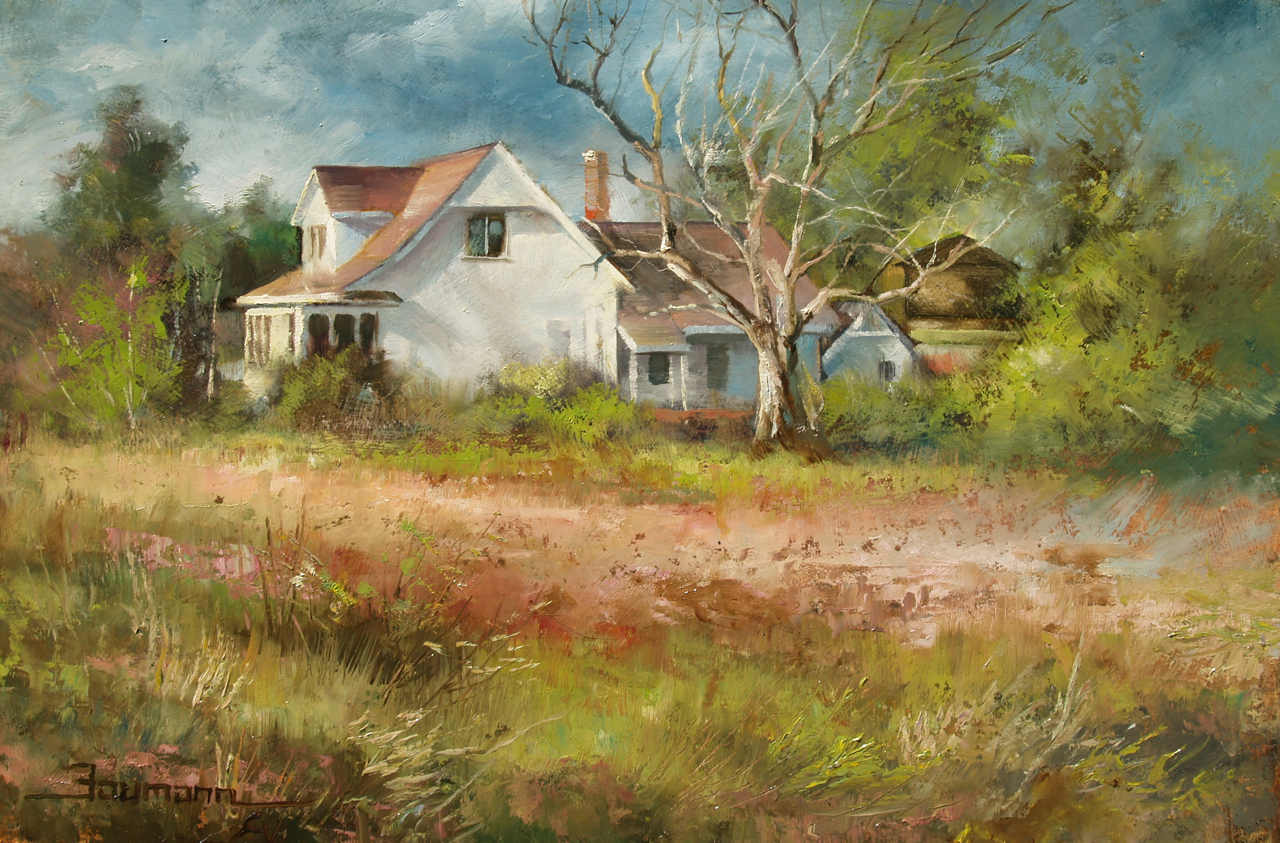“Farmhouse Near Winter’s Cutoff” by Stefan Baumann
I painted today’s painting, “Farmhouse Near Winter’s Cutoff,” in a different way than usual. I painted it entirely from memory in my studio in two hours. I pass this place on the freeway every time I drive to San Jose to teach my classes. Each time I see this scene, I think to myself, “How would I paint that?” This painting is the outcome of practicing lots of memory exercises.
In this day of instant gratification with TVs, videos, computer games and digital photography, we look less to the natural world for visual pleasure. Many cannot see the beauty that is in front of their eyes, feel absorbed by an awesome view, or even have an opinion of it. Since so much stimulation comes at us so fast, we learn to filter out and edit everything, making us neutral to so much. These filters also keep us from feeling our emotions.
When artists first learn to paint, they are concerned with placing paint on the canvas, mixing colors, and creating a good composition. Later, the relationship between the artist and his work becomes more personal, and the purpose of painting becomes more about adding what the artist feels about the subject into the paintings.
No one can teach another person how to feel. However, it seems to me that if an artist feels nothing at all – not magic or romance, not awe or wonder – then he or she is missing the best of what art can be. The artistically sensitive individual finds meaning and purpose in everything. To these people, a simple seed represents life and a sunbeam can be the touch of god. Artists who bring their experiences, interpretations, and feelings into their art elevate themselves, their craft, and ultimately the viewer to a higher level of being.
When I paint a painting, I am in tune with my feelings about the subject. How do I accomplish that? I look at my subject as if I was young child, seeing the subject for the first time. If you do this, you might see the world with awe and wonder, and feel the connection you have with everything around you. Feelings come from seeing what is in front of you, not just looking. Witness the texture, see the color, look for the light and shadow; enjoy these simple pleasures of sight that are often forgotten and ignored nowadays. Look at your subject with wonder, see the curves, notice the light – is it warm or cool? Feel the subject. Close your eyes, interpret it in your mind, enhance it, turn up the volume to increase the brightness, soften the edges, and add atmosphere. See it with your soul, then paint exactly what you see and feel.
Imagine if this were the last time you ever would be able to see a subject again – an apple, a sunset, your mother’s eyes. Choose a subject, and after studying it, close your eyes for a long while and see it in your mind. Now, without looking at the subject again, paint it. Express! Do not copy it. You will be surprised what you did not see. The mind is a muscle just like your abs. If you do not use it, you will lose it. One has to work out a long time to get stronger. If you do this memory exercise at least once a week, you will see that your ability to paint what you remember seeing and feeling will improve.
Now, imagine seeing a subject, person, place or thing you remember from your past, like your first house, pet, or flowers in a garden. In your mind, change the light effects, your perspective, your mood, and you will find that there are endless possibilities. Look at the vision in your mind with awe and wonder, and see it as if you are seeing it for the first time. Call a friend, a relative, or a neighbor, and describe it to them. Write it down on a piece of paper, or draw it. Be inspired by new sensations, new possibilities, and always look for new ways of expressing yourself.
___________________________________________
Plein air and Alla Prima artist Stefan Baumann, host of the PBS painting series “The Grand View, America’s National Park through the eyes of an artist” and author of “Observations Of Art and Nature,” travels in his vintage travel trailer painting America’s western landscape. Baumann paints outdoors with oils and canvas capturing stunning vistas, wildlife, western landscapes, National Parks and still life, thrilling art collectors throughout the world. He has many collectors acquiring his paintings as investment internationally. His painting style is called Romantic Realism with Lumunism and the extraordinary way he captures the effect of light is a truly an American Style used to paint the Western Landscape. He can be seen painting in Yellowstone, Yosemite and in the Grand Canyon and Baumann’s “how to paint” DVDs filmed on location in the National Parks are the very best on the market.

